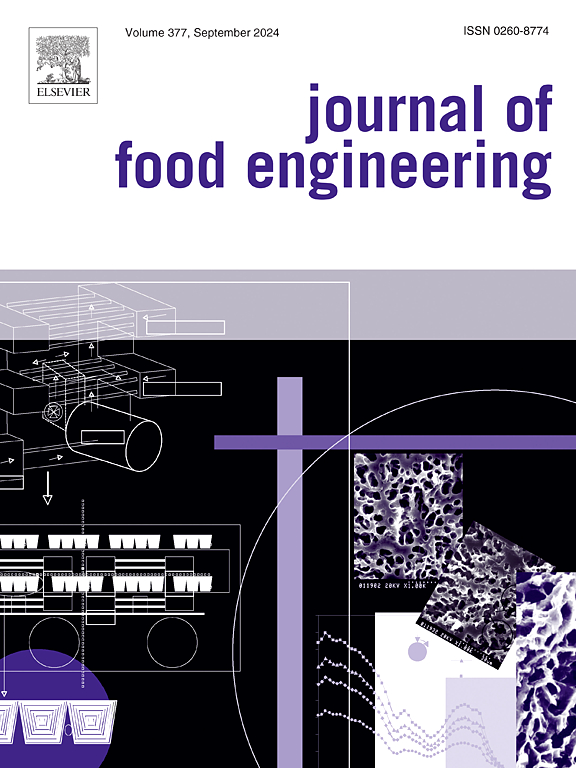Multiscale pore drives mechanical properties and storage stability in peach crisps
IF 5.8
2区 农林科学
Q1 ENGINEERING, CHEMICAL
引用次数: 0
Abstract
Multi-scale pore structures are formed during the drying of fruits and vegetables, and the size and distribution of micron- and nanometer-sized pores greatly affect the mechanical properties and storage quality of fruit and vegetable crisps. In this study, we constructed peach crisps with different pore structures using sucrose (SUC) and xylo-oligosaccharide (XOS) impregnation, vacuum freeze-drying (FD), and freeze drying combined with explosion puffing drying (FP). The effects of two-dimensional, three-dimensional, and micro-/nanopore sizes on the mechanical properties and storage quality of peach crisps was analyzed. The size of the pores in the peach crisps ranged from 50 to 300 μm. Notably, FD dried peach crisps exhibited a greater pore distribution in the 1–10 μm range, which FP dried products have no pore distribution in this range. After FP, the proportion of macropores increased significantly. Sugar impregnation led to thicker cell walls, a reduced proportion of micron macropores, a more uniform pore distribution, and an increased fractal dimension. The surface of the XOS-impregnated crunchy flakes became rougher, facilitating the formation of smaller pores and enhancing the pore-throat ratio. In terms of mechanical properties and storage attributes, freeze-dried peach crisps had lower hardness and storage quality. Both sugar impregnation and FP improved the hardness and crispness of peach crisps, while reducing the moisture absorption and vibration breakage rate. Correlation analyses indicated that nanoscale porosity positively influenced hardness and storage quality, whereas micron-sized porosity positively affected the mechanical property index, but negatively affected storage quality. These findings suggest that nanoscale pores can enhance the hardness of crisps and help maintain a better storage quality. Conversely, microscale pores can promote the formation of a crispiness but may compromise storage quality.
多尺度孔隙对桃薯片力学性能和贮存稳定性的影响
果蔬干燥过程中会形成多尺度孔隙结构,微米级和纳米级孔隙的大小和分布极大地影响着果蔬脆片的力学性能和贮藏品质。本研究采用蔗糖(SUC)和低聚木糖(XOS)浸渍、真空冷冻干燥(FD)和冷冻干燥与爆炸膨化干燥(FP)相结合的方法制备了不同孔隙结构的桃仁薯片。分析了二维、三维和微/纳米孔径对桃仁脆片力学性能和贮藏品质的影响。桃仁薯片孔隙大小在50 ~ 300 μm之间。值得注意的是,FD干桃片在1 ~ 10 μm范围内的孔隙分布更大,而FP干桃片在此范围内没有孔隙分布。FP处理后,大孔比例显著增加。糖浸渍导致细胞壁增厚,微米级大孔比例减少,孔分布更加均匀,分形维数增加。xos浸渍的脆片表面变得粗糙,有利于形成较小的孔隙,提高了孔喉比。冻干桃仁的硬度和贮藏品质均较低。糖浸渍和FP均提高了桃脆片的硬度和脆度,同时降低了桃脆片的吸湿率和振动破碎率。相关分析表明,纳米级孔隙度对硬度和贮藏质量有积极影响,微米级孔隙度对力学性能指标有积极影响,但对贮藏质量有消极影响。这些发现表明,纳米级孔隙可以提高薯片的硬度,并有助于保持更好的储存质量。相反,微孔可以促进松脆的形成,但可能会损害储存质量。
本文章由计算机程序翻译,如有差异,请以英文原文为准。
求助全文
约1分钟内获得全文
求助全文
来源期刊

Journal of Food Engineering
工程技术-工程:化工
CiteScore
11.80
自引率
5.50%
发文量
275
审稿时长
24 days
期刊介绍:
The journal publishes original research and review papers on any subject at the interface between food and engineering, particularly those of relevance to industry, including:
Engineering properties of foods, food physics and physical chemistry; processing, measurement, control, packaging, storage and distribution; engineering aspects of the design and production of novel foods and of food service and catering; design and operation of food processes, plant and equipment; economics of food engineering, including the economics of alternative processes.
Accounts of food engineering achievements are of particular value.
 求助内容:
求助内容: 应助结果提醒方式:
应助结果提醒方式:


